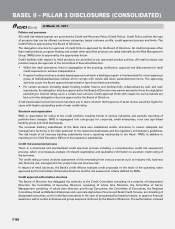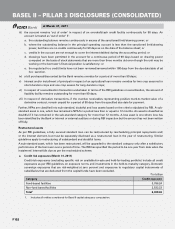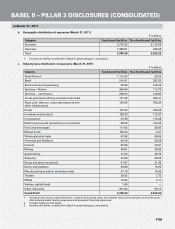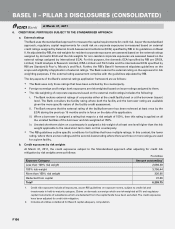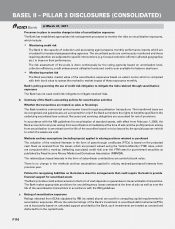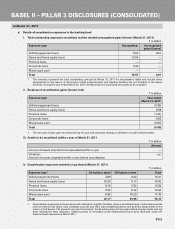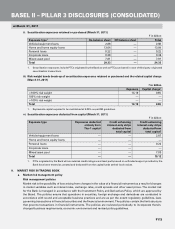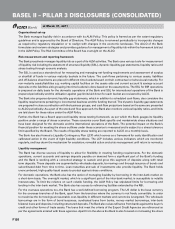ICICI Bank 2011 Annual Report Download - page 188
Download and view the complete annual report
Please find page 188 of the 2011 ICICI Bank annual report below. You can navigate through the pages in the report by either clicking on the pages listed below, or by using the keyword search tool below to find specific information within the annual report.
F110
Processes in place to monitor change in risks of securitisation exposures
The Bank has established appropriate risk management processes to monitor the risks on securitisation exposures,
which include:
• Monitoring credit risk
The Bank in the capacity of collection and processing agent prepares monthly performance reports which are
circulated to investors/assignees/rating agencies. The securitised pools are continuously monitored and those
requiring attention are subjected to specific interventions (e.g. focused collection efforts in affected geographies
etc.) to improve their performance.
The risk assessment of the pools is done continuously by the rating agencies based on amortisation level,
collection efficiency, credit enhancement utilisation levels and credit cover available for balance deal tenor.
• Monitoring market risk
The Bank ascertains market value of the securitisation exposures based on extant norms which is compared
with their book value to assess the marked to market impact of these exposures monthly.
Bank’s policy governing the use of credit risk mitigation to mitigate the risks retained through securitisation
exposures
The Bank has not used credit risk mitigants to mitigate retained risks.
b. Summary of the Bank’s accounting policies for securitisation activities
Whether the transactions are treated as sales or financings
The Bank transfers commercial and consumer loans through securitisation transactions. The transferred loans are
de-recognised and gains/losses are accounted for only if the Bank surrenders the rights to benefits specified in the
underlying securitised loan contract. Recourse and servicing obligations are accounted for net of provisions.
In accordance with the RBI guidelines for securitisation of standard assets, with effect from February 1, 2006, the
Bank accounts for any loss arising from securitisation immediately at the time of sale and the profit/premium arising
from securitisation is amortised over the life of the securities issued or to be issued by the special purpose vehicle
to which the assets are sold.
Methods and key assumptions (including inputs) applied in valuing positions retained or purchased
The valuation of the retained interests in the form of pass-through certificates (PTCs) is based on the projected
cash flows as received from the issuer, which are present valued using the Yield-to-Maturity (YTM) rates, which
are computed with a mark-up (reflecting associated credit risk) over the YTM rates for government securities as
published by Fixed Income Money Market and Derivatives Association (FIMMDA).
The retained/purchased interests in the form of subordinate contributions are carried at book value.
There is no change in the methods and key assumptions applied in valuing retained/purchased interests from
previous year.
Policies for recognising liabilities on the balance sheet for arrangements that could require the bank to provide
financial support for securitised assets
The Bank provides credit enhancements in the form of cash deposits or guarantees in its securitisation transactions.
The Bank makes appropriate provisions for any delinquency losses assessed at the time of sale as well as over the
life of the securitisation transactions in accordance with the RBI guidelines.
c. Rating of securitisation exposures
Ratings obtained from ECAIs stipulated by RBI (as stated above) are used for computing capital requirements for
securisation exposures. Where the external ratings of the Bank’s investment in securitised debt instruments/PTCs
are at least partly based on unfunded support provided by the Bank, such investments are treated as unrated and
deducted from the capital funds.
BASEL II – PILLAR 3 DISCLOSURES (CONSOLIDATED)
at March 31, 2011


